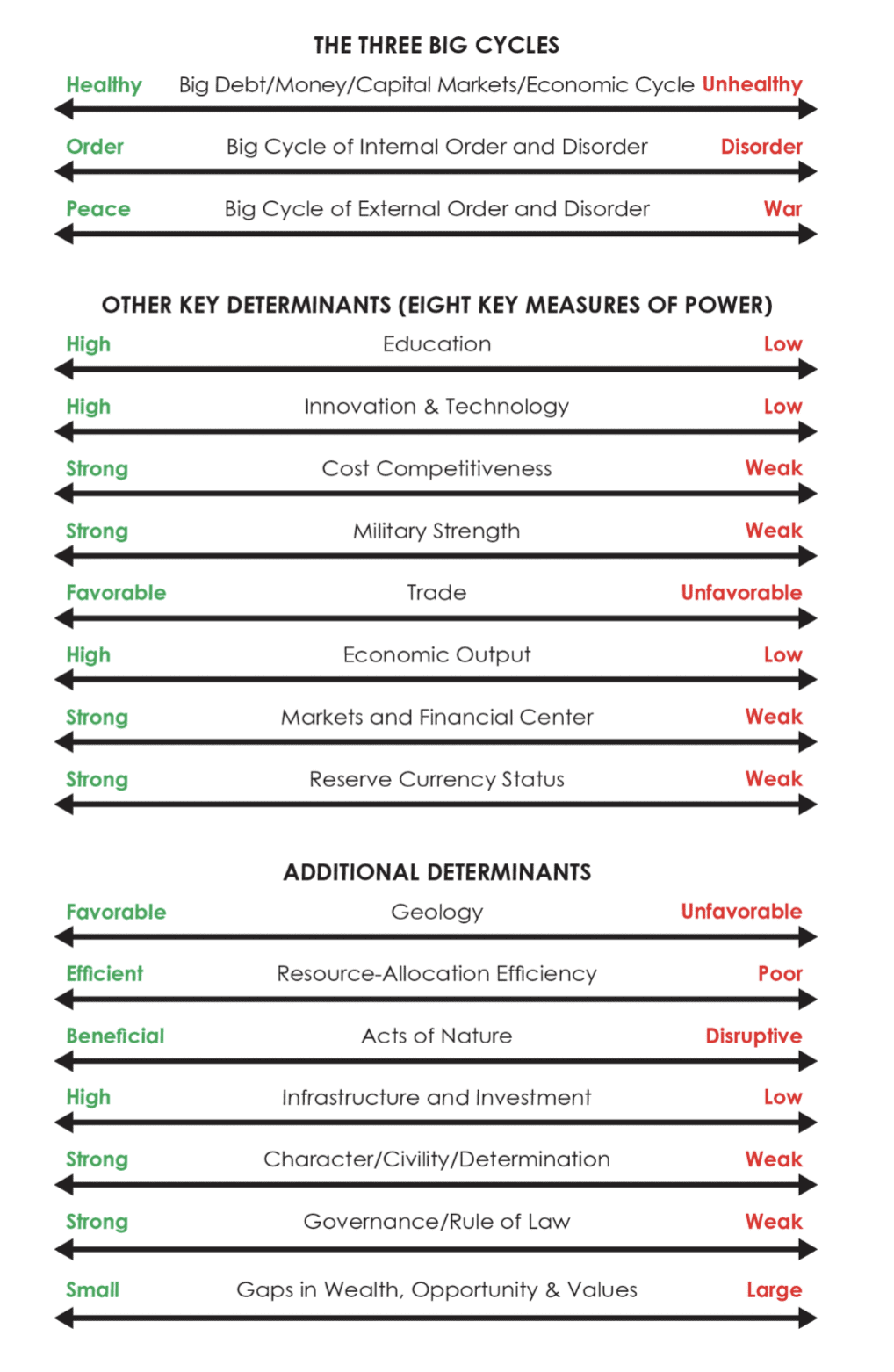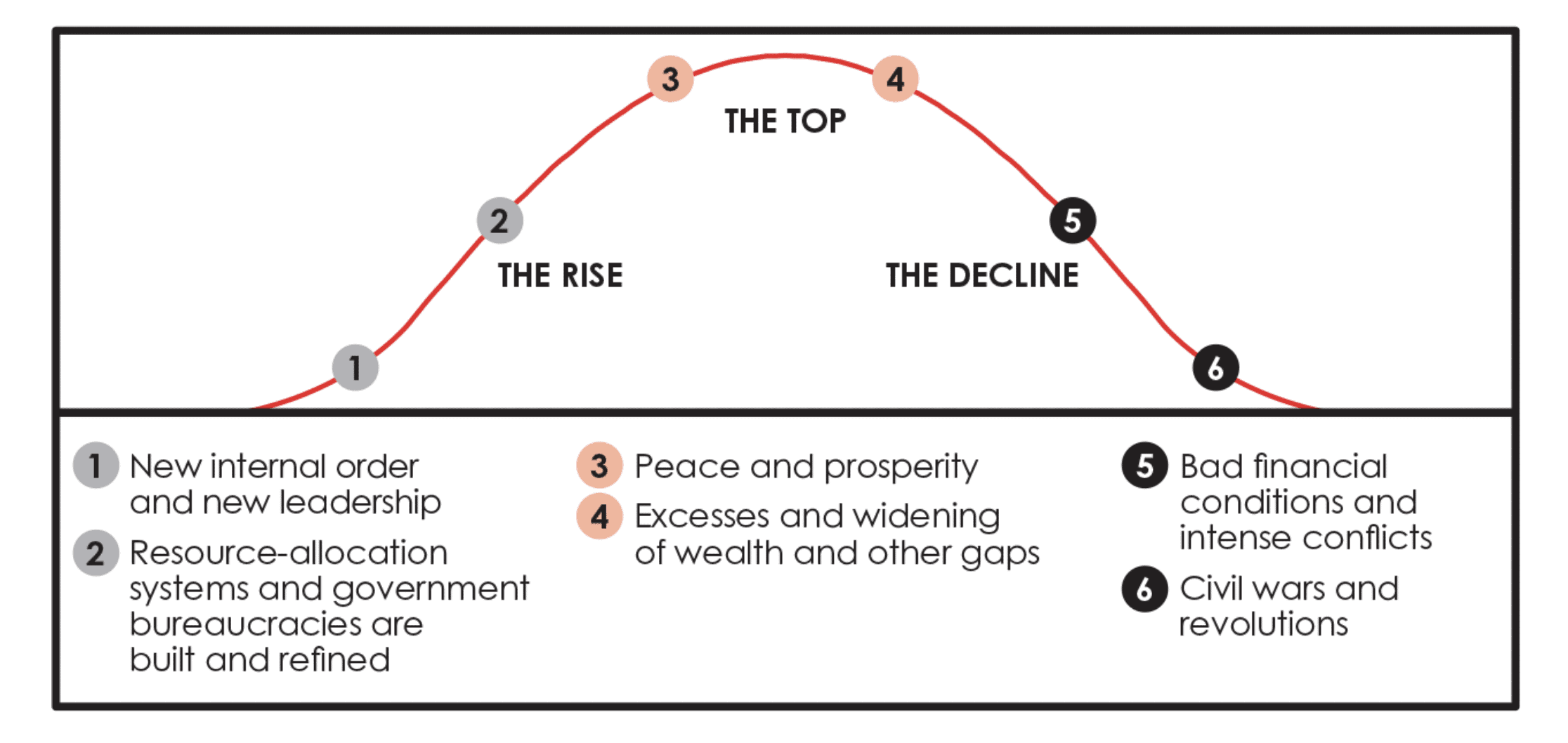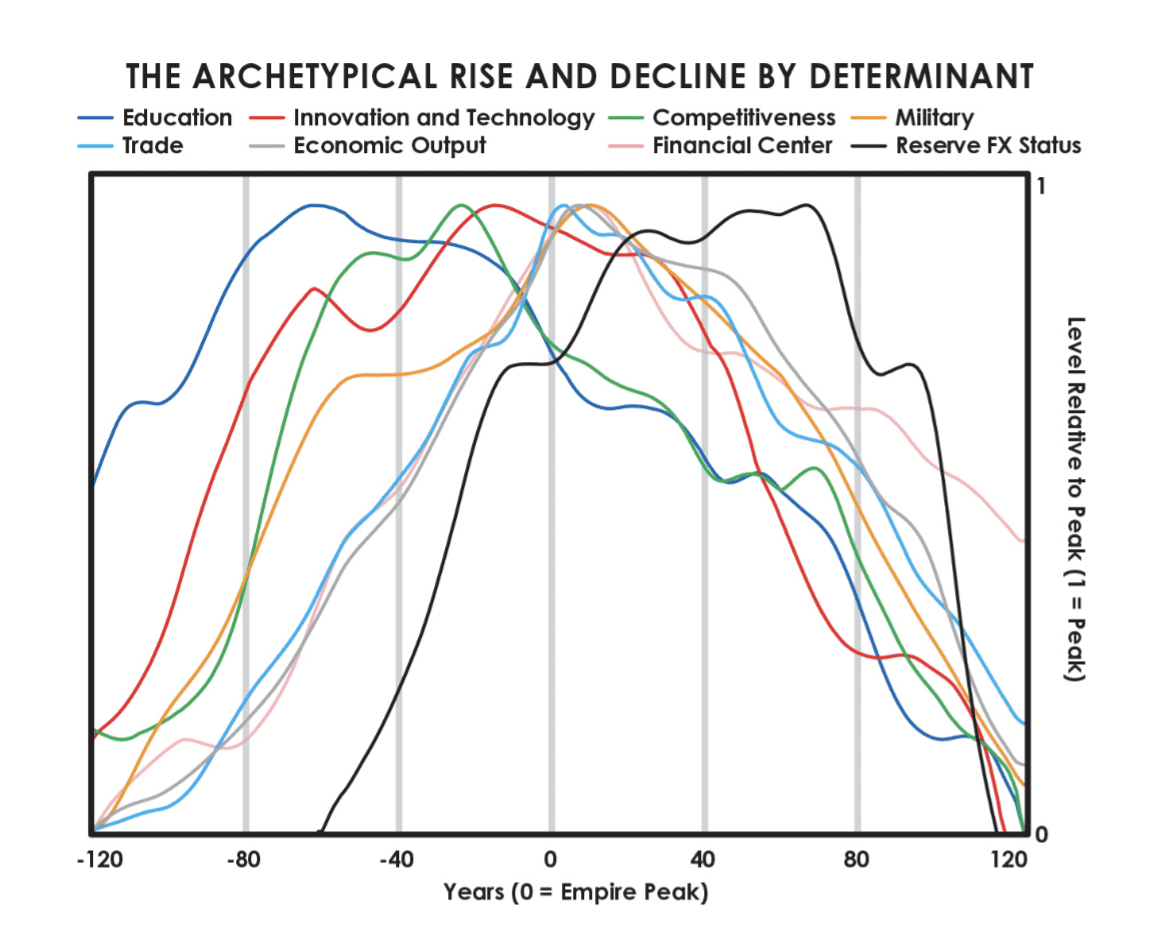Preamble from Barnaby
Ray Dalio published The Changing World Order: Why Nations Succeed and Fail in November 2021. It’s been hugely influential and impacted the way many senior business leaders see the world and expect the future to unfold. This is of particular interest to me living in Hong Kong and possibly being at the epicenter of the colliding geopolitical plates of the US, China, Europe, the Middle East and Russia.
The book covers five centuries of history and Dalio unpacks a lot.
What follows below are the extracts which impacted me the most – mostly direct lifts, with summaries from me where needed.
How the world works – why nations succeed and fail
There are 18 important determinants that have explained almost all of the basic ebbs and flows through time that have caused ups and downs in empires.
Throughout time, the formula for success has been a system in which well-educated people, operating civilly with each other, come up with innovations, receive funding through capital markets, and own the means by which their innovations are turned into the production and allocation of resources, allowing them to be rewarded by profit making.

The evolutionary trend
Evolution is an upward movement toward improvement that occurs because of adaption and learning. Around it are cycles. To me, most everything transpires in an ascending trajectory of improvement with cycles around it.

The 3 important cycles
1. Debt/money/economic cycle
Short term cycles
Consists of alternating periods of central banks stimulating the economy by creating money and credit and then attempting to slowing it down by reducing the flow of them. They never get this precisely right, which is what produces the excesses that lead to bubbles, busts, and the cycle beginning again.
This cycle typically takes about eight years, give or take a few, though the timing is less the result of how long it’s been since the last one and more the result of the underlying economic drivers themselves.
The last cycle began in April 2020 with largest dose of fiscal and monetary stimulation ever.
With the amounts of stimulation injected into this recent downturn being so enormous (especially in the US), with the slack in the major economies being relatively limited (especially in the US), with the signs of bubbles now being moderate to strong, and with the interest rate sensitivity of markets and the economy being high, my guess is that the next downturn will come sooner than is typical.
Also, I would expect any downturn to be promptly followed by a quick reversal of central bank policies toward the next big round of stimulation.
Long term cycle
Typically lasts 50 – 100 years (contains 6 – 10 short term cycles)
Because the crises that occur as these long-term debt cycles play out happen only once in a lifetime, most people don’t expect them. As a result they typically take people by surprise and do a lot of harm.
The long-term debt cycle that is now in the late-cycle phase was designed in 1944 in Bretton Woods, New Hampshire, and began in 1945, when World War II ended and the dollar/US-dominated world order began.
The stages are
- Little or no debt, money is hard (e.g. metal coins)
- Paper claims on hard money (via Banks)
- Increased debt
- Debt crises, defaults, devaluations and printing of money
- Fiat money and debasement of money
- Flight back into hard money
Typically, a country loses its reserve currency status when there is an already established loss of economic and political primacy.
2. Internal order and disorder cycle
The stages are
- New order begins and new leadership consolidates power
- Resource-allocation systems and government bureaucracies are built and refined
- There is peace and prosperity
- There are great excesses in spending and debt and widening of wealth and political gaps
- Very bad financial conditions and intense conflict
- Civil wars/revolutions, which leads to stage 1

As far as the internal order/disorder cycle is concerned, it typically lags the debt/economic cycle because people are less confrontational in good times than in bad ones. When these cycles interact strongly, it can lead to major changes.
Based on my estimates, there is a significant chance the next downturn will come around the time of the next presidential election in the US.
3. External order and disorder cycle
“For the first time in my life, the United States is encountering a true rival power.”

The external order/disorder cycle has traditionally followed the path of accelerating conflicts that lead to wars. As mentioned earlier, the United States and China are now preparing themselves for increasing intensity in the five types of war.
- They are operating with roughly five-year plans to gain greater amounts of self-sufficiency and preparedness for each of these wars, which will give them greater ability to wage them, though it’s doubtful that either will become dominant enough to ignore the deterrent of mutually assured destruction.
- Since China’s strength is gaining relative to that of the US, it would seem to imply that important changes will come neither too soon nor too far ahead.
- As mentioned earlier, there is significant risk that we are approaching a conflict between an unstoppable force and an immovable object regarding Taiwan and the East and South China Seas—i.e., China is an unstoppable force for change to Taiwan’s current status and the United States is an immovable object against it.
Beyond the US and China, other nations—most notably Russia, India, Japan, Korea, and the key European and Middle Eastern powers—will play important roles in this global drama. Over the next five years or so, alliances are likely to harden.
These things point toward the next big risk point being around five years from this writing, give or take a couple of years. To reiterate, there is nothing precise about the timing of these cycles. They’re like hurricane/typhoon seasons; we know they are likely to happen at roughly certain times so we prepare for them, and when those times come, we watch for storms emerging, follow them closely, and do our best to get out of harm’s way.
Views on investing and the future
Bet on evolution
In the markets and in life, to be successful one should bet on the upside that comes from a) evolution that leads to productivity improvements, but not so aggressively that b) cycles and bumps along the way knock you out of the game.
Bet on new discoveries (AI and Quantum Computing)
I believe that humanity’s evolution through its inventiveness is accelerating and that most people will benefit from it.
The most significant inventions we are now seeing, and that we know we will see many more of, improve the quality and quantity of all thinking.
These inventions are coming in the forms of advances in computers, AI, and other thinking-related technologies.
Because they can be applied to many domains of human activity and decision making, it seems obvious to me that the rate of invention and improvement in most areas will accelerate at an even faster pace the abilities of both computers and humans will improve at an increasing pace.
Perhaps most importantly, advances in and the wider use of quantum computing with AI will lead to unimaginable advances in rates of learning and improvement and changes in global wealth and power.
These changes will occur in varying degrees in the next five to 20 years, but I believe they will add up to the greatest shift in wealth and power that the world has ever seen. Quantum computing with AI will be to traditional computing what the computer was to the abacus, providing humanity with vastly more power to see, understand, and shape things. That makes me long-term very optimistic and eager to bet on great new discoveries.
Identifying, understanding, and adapting to paradigm shifts is essential, even if one can’t anticipate them—though trying to anticipate them with good indicators that help is important too.
Dealing with what you know and don’t know
Betting on the future is betting on probabilities and nothing is certain, not even the probabilities. That’s just the way it is.
In a nutshell, here’s what I try to do:
- Know all the possibilities,
- think about the worst-case scenarios, and
- then find ways to eliminate the intolerable ones. Identifying and eliminating the intolerable worst-case scenarios comes first.
That’s because the most important thing in playing the game (of life or the markets) is to not get knocked out of it.
I learned that from a big mistake I made in 1982, which nearly broke me. After that painful loss I calculated what my basic needs would cost and worked toward having enough money stashed away so my worst-case scenario would be tolerable.
As I built up from nothing, I remember regularly calculating how many weeks, then months, and then years my family and I would be fine if not another dime came in.
I now have an “end of the world” portfolio that I know will keep us fine in the worst-case scenarios, and I build from there.

